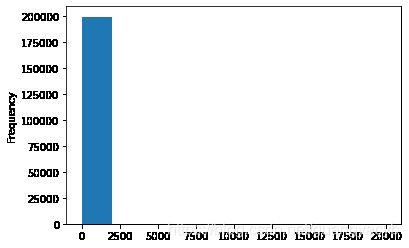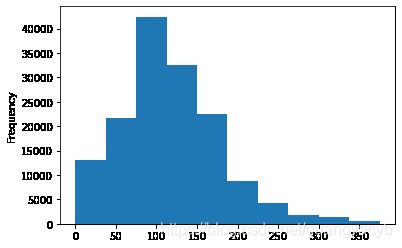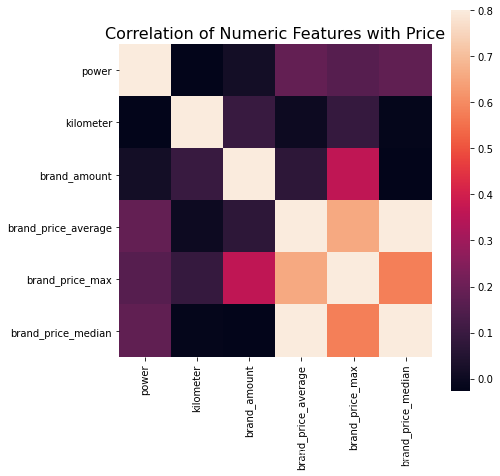特征工程用于对特征进行进一步分析,并对数据进行处理
常见特征工程包括:
- 异常处理:
通过箱线图(或 3-Sigma)分析删除异常值;
BOX-COX 转换(处理有偏分布);
长尾截断;
- 特征归一化/标准化:
标准化(转换为标准正态分布);
归一化(抓换到 [0,1] 区间);
针对幂律分布,可以采用公式:
- 数据分桶:
等频分桶;
等距分桶;
Best-KS 分桶(类似利用基尼指数进行二分类);
卡方分桶;
- 缺失值处理:
不处理(针对类似 XGBoost 等树模型);
删除(缺失数据太多);
插值补全,包括均值/中位数/众数/建模预测/多重插补/压缩感知补全/矩阵补全等;
分箱,缺失值一个箱;
- 特征构造:
构造统计量特征,报告计数、求和、比例、标准差等;
时间特征,包括相对时间和绝对时间,节假日,双休日等;
地理信息,包括分箱,分布编码等方法;
非线性变换,包括 log/ 平方/ 根号等;
特征组合,特征交叉;
( 1+1+ )
- 特征筛选
过滤式(filter):先对数据进行特征选择,然后在训练学习器,常见的方法有 Relief/方差选择发/相关系
数法/卡方检验法/互信息法;
包裹式(wrapper):直接把最终将要使用的学习器的性能作为特征子集的评价准则,常见方法有
LVM(Las Vegas Wrapper) ;
嵌入式(embedding):结合过滤式和包裹式,学习器训练过程中自动进行了特征选择,常见的有
lasso 回归;
- 降维
PCA/ LDA/ ICA;
特征选择也是一种降维
导入数据
import pandas as pd
import numpy as np
import matplotlib
import matplotlib.pyplot as plt
import seaborn as sns
from operator import itemgetter
%matplotlib inline
train = pd.read_csv('used_car_train_20200313.csv', sep=' ')
test = pd.read_csv('used_car_testA_20200313.csv', sep=' ')
print(train.shape)
print(test.shape)
(150000, 31)
(50000, 30)
train.head()
|
SaleID |
name |
regDate |
model |
brand |
bodyType |
fuelType |
gearbox |
power |
kilometer |
... |
v_5 |
v_6 |
v_7 |
v_8 |
v_9 |
v_10 |
v_11 |
v_12 |
v_13 |
v_14 |
| 0 |
0 |
736 |
20040402 |
30.0 |
6 |
1.0 |
0.0 |
0.0 |
60 |
12.5 |
... |
0.235676 |
0.101988 |
0.129549 |
0.022816 |
0.097462 |
-2.881803 |
2.804097 |
-2.420821 |
0.795292 |
0.914762 |
| 1 |
1 |
2262 |
20030301 |
40.0 |
1 |
2.0 |
0.0 |
0.0 |
0 |
15.0 |
... |
0.264777 |
0.121004 |
0.135731 |
0.026597 |
0.020582 |
-4.900482 |
2.096338 |
-1.030483 |
-1.722674 |
0.245522 |
| 2 |
2 |
14874 |
20040403 |
115.0 |
15 |
1.0 |
0.0 |
0.0 |
163 |
12.5 |
... |
0.251410 |
0.114912 |
0.165147 |
0.062173 |
0.027075 |
-4.846749 |
1.803559 |
1.565330 |
-0.832687 |
-0.229963 |
| 3 |
3 |
71865 |
19960908 |
109.0 |
10 |
0.0 |
0.0 |
1.0 |
193 |
15.0 |
... |
0.274293 |
0.110300 |
0.121964 |
0.033395 |
0.000000 |
-4.509599 |
1.285940 |
-0.501868 |
-2.438353 |
-0.478699 |
| 4 |
4 |
111080 |
20120103 |
110.0 |
5 |
1.0 |
0.0 |
0.0 |
68 |
5.0 |
... |
0.228036 |
0.073205 |
0.091880 |
0.078819 |
0.121534 |
-1.896240 |
0.910783 |
0.931110 |
2.834518 |
1.923482 |
5 rows × 31 columns
train.columns
Index(['SaleID', 'name', 'regDate', 'model', 'brand', 'bodyType', 'fuelType',
'gearbox', 'power', 'kilometer', 'notRepairedDamage', 'regionCode',
'seller', 'offerType', 'creatDate', 'price', 'v_0', 'v_1', 'v_2', 'v_3',
'v_4', 'v_5', 'v_6', 'v_7', 'v_8', 'v_9', 'v_10', 'v_11', 'v_12',
'v_13', 'v_14'],
dtype='object')
test.columns
Index(['SaleID', 'name', 'regDate', 'model', 'brand', 'bodyType', 'fuelType',
'gearbox', 'power', 'kilometer', 'notRepairedDamage', 'regionCode',
'seller', 'offerType', 'creatDate', 'v_0', 'v_1', 'v_2', 'v_3', 'v_4',
'v_5', 'v_6', 'v_7', 'v_8', 'v_9', 'v_10', 'v_11', 'v_12', 'v_13',
'v_14'],
dtype='object')
删除异常值
def outliers_proc(data, col_name, scale=3):
"""
用于清洗异常值,默认用 box_plot(scale=3)进行清洗
:param data: 接收 pandas 数据格式
:param col_name: pandas 列名
:param scale: 尺度
:return:
"""
def box_plot_outliers(data_ser, box_scale):
"""
利用箱线图去除异常值
:param data_ser: 接收 pandas.Series 数据格式
:param box_scale: 箱线图尺度,
:return:
"""
iqr = box_scale * (data_ser.quantile(0.75) - data_ser.quantile(0.25))
val_low = data_ser.quantile(0.25) - iqr
val_up = data_ser.quantile(0.75) + iqr
rule_low = (data_ser < val_low)
rule_up = (data_ser > val_up)
return (rule_low, rule_up), (val_low, val_up)
data_n = data.copy()
data_series = data_n[col_name]
rule, value = box_plot_outliers(data_series, box_scale=scale)
index = np.arange(data_series.shape[0])[rule[0] | rule[1]]
print("Delete number is: {}".format(len(index)))
data_n = data_n.drop(index)
data_n.reset_index(drop=True, inplace=True)
print("Now column number is: {}".format(data_n.shape[0]))
index_low = np.arange(data_series.shape[0])[rule[0]]
outliers = data_series.iloc[index_low]
print("Description of data less than the lower bound is:")
print(pd.Series(outliers).describe())
index_up = np.arange(data_series.shape[0])[rule[1]]
outliers = data_series.iloc[index_up]
print("Description of data larger than the upper bound is:")
print(pd.Series(outliers).describe())
fig, ax = plt.subplots(1, 2, figsize=(10, 7))
sns.boxplot(y=data[col_name], data=data, palette="Set1", ax=ax[0])
sns.boxplot(y=data_n[col_name], data=data_n, palette="Set1", ax=ax[1])
return data_n
train = outliers_proc(train, 'power', scale=3)
Delete number is: 963
Now column number is: 149037
Description of data less than the lower bound is:
count 0.0
mean NaN
std NaN
min NaN
25% NaN
50% NaN
75% NaN
max NaN
Name: power, dtype: float64
Description of data larger than the upper bound is:
count 963.000000
mean 846.836968
std 1929.418081
min 376.000000
25% 400.000000
50% 436.000000
75% 514.000000
max 19312.000000
Name: power, dtype: float64

特征构造
train['train']=1
test['train']=0
data = pd.concat([train, test], ignore_index=True, sort=False)
data['used_time'] = (pd.to_datetime(data['creatDate'], format='%Y%m%d', errors='coerce') -
pd.to_datetime(data['regDate'], format='%Y%m%d', errors='coerce')).dt.days
data['used_time'].isnull().sum()
15072
data['city'] = data['regionCode'].apply(lambda x : str(x)[:-3])
train_gb = train.groupby("brand")
all_info = {}
for kind, kind_data in train_gb:
info = {}
kind_data = kind_data[kind_data['price'] > 0]
info['brand_amount'] = len(kind_data)
info['brand_price_max'] = kind_data.price.max()
info['brand_price_median'] = kind_data.price.median()
info['brand_price_min'] = kind_data.price.min()
info['brand_price_sum'] = kind_data.price.sum()
info['brand_price_std'] = kind_data.price.std()
info['brand_price_average'] = round(kind_data.price.sum() / (len(kind_data) + 1), 2)
all_info[kind] = info
brand_fe = pd.DataFrame(all_info).T.reset_index().rename(columns={"index": "brand"})
data = data.merge(brand_fe, how='left', on='brand')
pd.DataFrame(all_info)
|
0 |
1 |
2 |
3 |
4 |
5 |
6 |
7 |
8 |
9 |
... |
30 |
31 |
32 |
33 |
34 |
35 |
36 |
37 |
38 |
39 |
| brand_amount |
3.142900e+04 |
1.365600e+04 |
3.180000e+02 |
2.461000e+03 |
1.657500e+04 |
4.662000e+03 |
1.019300e+04 |
2.360000e+03 |
2.070000e+03 |
7.299000e+03 |
... |
9.400000e+02 |
318.000000 |
5.880000e+02 |
2.010000e+02 |
227.000000 |
180.000000 |
228.000000 |
3.310000e+02 |
65.000000 |
9.000000 |
| brand_price_max |
6.850000e+04 |
8.400000e+04 |
5.580000e+04 |
3.750000e+04 |
9.999900e+04 |
3.150000e+04 |
3.599000e+04 |
3.890000e+04 |
9.999900e+04 |
6.853000e+04 |
... |
2.320000e+04 |
11000.000000 |
3.350000e+04 |
6.500000e+04 |
2900.000000 |
28900.000000 |
20900.000000 |
8.650000e+04 |
8999.000000 |
14500.000000 |
| brand_price_median |
3.199000e+03 |
6.399000e+03 |
7.500000e+03 |
4.990000e+03 |
5.999000e+03 |
2.300000e+03 |
1.800000e+03 |
2.600000e+03 |
2.270000e+03 |
1.400000e+03 |
... |
3.295000e+03 |
1000.000000 |
2.350000e+03 |
5.600000e+03 |
999.000000 |
950.000000 |
2250.000000 |
1.325000e+04 |
2850.000000 |
1900.000000 |
| brand_price_min |
1.300000e+01 |
1.500000e+01 |
3.500000e+01 |
6.500000e+01 |
1.200000e+01 |
2.000000e+01 |
1.300000e+01 |
6.000000e+01 |
3.000000e+01 |
5.000000e+01 |
... |
5.000000e+01 |
50.000000 |
5.000000e+01 |
9.800000e+02 |
60.000000 |
50.000000 |
150.000000 |
5.500000e+02 |
99.000000 |
750.000000 |
| brand_price_sum |
1.737197e+08 |
1.240446e+08 |
3.766241e+06 |
1.595423e+07 |
1.382791e+08 |
1.541432e+07 |
3.645752e+07 |
9.905909e+06 |
1.001717e+07 |
1.780527e+07 |
... |
3.939145e+06 |
560155.000000 |
2.360095e+06 |
1.839801e+06 |
231776.000000 |
297977.000000 |
816001.000000 |
5.371844e+06 |
215620.000000 |
39480.000000 |
| brand_price_std |
6.261372e+03 |
8.988865e+03 |
1.057622e+04 |
5.396328e+03 |
8.089863e+03 |
3.344690e+03 |
4.562233e+03 |
4.752584e+03 |
6.053233e+03 |
2.975343e+03 |
... |
3.659577e+03 |
1829.079211 |
4.394596e+03 |
9.637135e+03 |
554.118445 |
3325.933365 |
3922.715389 |
1.354118e+04 |
2140.083145 |
5520.867233 |
| brand_price_average |
5.527190e+03 |
9.082860e+03 |
1.180640e+04 |
6.480190e+03 |
8.342130e+03 |
3.305670e+03 |
3.576370e+03 |
4.195640e+03 |
4.836880e+03 |
2.439080e+03 |
... |
4.186130e+03 |
1755.970000 |
4.006950e+03 |
9.107930e+03 |
1016.560000 |
1646.280000 |
3563.320000 |
1.618025e+04 |
3266.970000 |
3948.000000 |
7 rows × 40 columns
pd.DataFrame(all_info).T.head()
|
brand_amount |
brand_price_max |
brand_price_median |
brand_price_min |
brand_price_sum |
brand_price_std |
brand_price_average |
| 0 |
31429.0 |
68500.0 |
3199.0 |
13.0 |
173719698.0 |
6261.371627 |
5527.19 |
| 1 |
13656.0 |
84000.0 |
6399.0 |
15.0 |
124044603.0 |
8988.865406 |
9082.86 |
| 2 |
318.0 |
55800.0 |
7500.0 |
35.0 |
3766241.0 |
10576.224444 |
11806.40 |
| 3 |
2461.0 |
37500.0 |
4990.0 |
65.0 |
15954226.0 |
5396.327503 |
6480.19 |
| 4 |
16575.0 |
99999.0 |
5999.0 |
12.0 |
138279069.0 |
8089.863295 |
8342.13 |
brand_fe.head()
|
brand |
brand_amount |
brand_price_max |
brand_price_median |
brand_price_min |
brand_price_sum |
brand_price_std |
brand_price_average |
| 0 |
0 |
31429.0 |
68500.0 |
3199.0 |
13.0 |
173719698.0 |
6261.371627 |
5527.19 |
| 1 |
1 |
13656.0 |
84000.0 |
6399.0 |
15.0 |
124044603.0 |
8988.865406 |
9082.86 |
| 2 |
2 |
318.0 |
55800.0 |
7500.0 |
35.0 |
3766241.0 |
10576.224444 |
11806.40 |
| 3 |
3 |
2461.0 |
37500.0 |
4990.0 |
65.0 |
15954226.0 |
5396.327503 |
6480.19 |
| 4 |
4 |
16575.0 |
99999.0 |
5999.0 |
12.0 |
138279069.0 |
8089.863295 |
8342.13 |
data.head()
|
SaleID |
name |
regDate |
model |
brand |
bodyType |
fuelType |
gearbox |
power |
kilometer |
... |
train |
used_time |
city |
brand_amount |
brand_price_max |
brand_price_median |
brand_price_min |
brand_price_sum |
brand_price_std |
brand_price_average |
| 0 |
0 |
736 |
20040402 |
30.0 |
6 |
1.0 |
0.0 |
0.0 |
60 |
12.5 |
... |
1 |
4385.0 |
1 |
10193.0 |
35990.0 |
1800.0 |
13.0 |
36457518.0 |
4562.233331 |
3576.37 |
| 1 |
1 |
2262 |
20030301 |
40.0 |
1 |
2.0 |
0.0 |
0.0 |
0 |
15.0 |
... |
1 |
4757.0 |
4 |
13656.0 |
84000.0 |
6399.0 |
15.0 |
124044603.0 |
8988.865406 |
9082.86 |
| 2 |
2 |
14874 |
20040403 |
115.0 |
15 |
1.0 |
0.0 |
0.0 |
163 |
12.5 |
... |
1 |
4382.0 |
2 |
1458.0 |
45000.0 |
8500.0 |
100.0 |
14373814.0 |
5425.058140 |
9851.83 |
| 3 |
3 |
71865 |
19960908 |
109.0 |
10 |
0.0 |
0.0 |
1.0 |
193 |
15.0 |
... |
1 |
7125.0 |
|
13994.0 |
92900.0 |
5200.0 |
15.0 |
113034210.0 |
8244.695287 |
8076.76 |
| 4 |
4 |
111080 |
20120103 |
110.0 |
5 |
1.0 |
0.0 |
0.0 |
68 |
5.0 |
... |
1 |
1531.0 |
6 |
4662.0 |
31500.0 |
2300.0 |
20.0 |
15414322.0 |
3344.689763 |
3305.67 |
5 rows × 41 columns
bin = [i*10 for i in range(31)]
data['power_bin'] = pd.cut(data['power'], bin, labels=False)
data[['power_bin', 'power']].head()
|
power_bin |
power |
| 0 |
5.0 |
60 |
| 1 |
NaN |
0 |
| 2 |
16.0 |
163 |
| 3 |
19.0 |
193 |
| 4 |
6.0 |
68 |
data = data.drop(['creatDate', 'regDate', 'regionCode'], axis=1)
print(data.shape)
data.columns
(199037, 39)
Index(['SaleID', 'name', 'model', 'brand', 'bodyType', 'fuelType', 'gearbox',
'power', 'kilometer', 'notRepairedDamage', 'seller', 'offerType',
'price', 'v_0', 'v_1', 'v_2', 'v_3', 'v_4', 'v_5', 'v_6', 'v_7', 'v_8',
'v_9', 'v_10', 'v_11', 'v_12', 'v_13', 'v_14', 'train', 'used_time',
'city', 'brand_amount', 'brand_price_max', 'brand_price_median',
'brand_price_min', 'brand_price_sum', 'brand_price_std',
'brand_price_average', 'power_bin'],
dtype='object')
data.to_csv('data_for_tree.csv', index=0)
data['power'].plot.hist()

train['power'].plot.hist()

from sklearn import preprocessing
min_max_scaler = preprocessing.MinMaxScaler()
data['power'] = np.log(data['power'] + 1)
data['power'] = ((data['power'] - np.min(data['power'])) / (np.max(data['power']) - np.min(data['power'])))
data['power'].plot.hist()

data['kilometer'].plot.hist()

data['kilometer'] = ((data['kilometer'] - np.min(data['kilometer'])) /
(np.max(data['kilometer']) - np.min(data['kilometer'])))
data['kilometer'].plot.hist()

def max_min(x):
return (x - np.min(x)) / (np.max(x) - np.min(x))
data['brand_amount'] = ((data['brand_amount'] - np.min(data['brand_amount'])) /
(np.max(data['brand_amount']) - np.min(data['brand_amount'])))
data['brand_price_average'] = ((data['brand_price_average'] - np.min(data['brand_price_average'])) /
(np.max(data['brand_price_average']) - np.min(data['brand_price_average'])))
data['brand_price_max'] = ((data['brand_price_max'] - np.min(data['brand_price_max'])) /
(np.max(data['brand_price_max']) - np.min(data['brand_price_max'])))
data['brand_price_median'] = ((data['brand_price_median'] - np.min(data['brand_price_median'])) /
(np.max(data['brand_price_median']) - np.min(data['brand_price_median'])))
data['brand_price_min'] = ((data['brand_price_min'] - np.min(data['brand_price_min'])) /
(np.max(data['brand_price_min']) - np.min(data['brand_price_min'])))
data['brand_price_std'] = ((data['brand_price_std'] - np.min(data['brand_price_std'])) /
(np.max(data['brand_price_std']) - np.min(data['brand_price_std'])))
data['brand_price_sum'] = ((data['brand_price_sum'] - np.min(data['brand_price_sum'])) /
(np.max(data['brand_price_sum']) - np.min(data['brand_price_sum'])))
data = pd.get_dummies(data, columns=['model', 'brand', 'bodyType', 'fuelType',
'gearbox', 'notRepairedDamage', 'power_bin'])
print(data.shape)
data.columns
(199037, 370)
Index(['SaleID', 'name', 'power', 'kilometer', 'seller', 'offerType', 'price',
'v_0', 'v_1', 'v_2',
...
'power_bin_20.0', 'power_bin_21.0', 'power_bin_22.0', 'power_bin_23.0',
'power_bin_24.0', 'power_bin_25.0', 'power_bin_26.0', 'power_bin_27.0',
'power_bin_28.0', 'power_bin_29.0'],
dtype='object', length=370)
data.to_csv('data_for_lr.csv', index=0)
特征筛选
过滤式
print(data['power'].corr(data['price'], method='spearman'))
print(data['kilometer'].corr(data['price'], method='spearman'))
print(data['brand_amount'].corr(data['price'], method='spearman'))
print(data['brand_price_average'].corr(data['price'], method='spearman'))
print(data['brand_price_max'].corr(data['price'], method='spearman'))
print(data['brand_price_median'].corr(data['price'], method='spearman'))
0.5728285196051496
-0.4082569701616764
0.058156610025581514
0.3834909576057687
0.259066833880992
0.38691042393409447
data_numeric = data[['power', 'kilometer', 'brand_amount', 'brand_price_average',
'brand_price_max', 'brand_price_median']]
correlation = data_numeric.corr()
f , ax = plt.subplots(figsize = (7, 7))
plt.title('Correlation of Numeric Features with Price',y=1,size=16)
sns.heatmap(correlation,square = True, vmax=0.8)

包裹式
!pip install mlxtend
Collecting mlxtend
Downloading mlxtend-0.17.2-py2.py3-none-any.whl (1.3 MB)
Requirement already satisfied: scipy>=1.2.1 in c:\anaconda3\envs\mytf\lib\site-packages (from mlxtend) (1.4.1)
Requirement already satisfied: setuptools in c:\anaconda3\envs\mytf\lib\site-packages (from mlxtend) (46.0.0.post20200311)
Requirement already satisfied: matplotlib>=3.0.0 in c:\anaconda3\envs\mytf\lib\site-packages (from mlxtend) (3.2.0)
Requirement already satisfied: scikit-learn>=0.20.3 in c:\anaconda3\envs\mytf\lib\site-packages (from mlxtend) (0.22.2.post1)
Requirement already satisfied: pandas>=0.24.2 in c:\anaconda3\envs\mytf\lib\site-packages (from mlxtend) (1.0.2)
Requirement already satisfied: numpy>=1.16.2 in c:\anaconda3\envs\mytf\lib\site-packages (from mlxtend) (1.18.1)
Requirement already satisfied: joblib>=0.13.2 in c:\anaconda3\envs\mytf\lib\site-packages (from mlxtend) (0.14.1)
Requirement already satisfied: cycler>=0.10 in c:\anaconda3\envs\mytf\lib\site-packages (from matplotlib>=3.0.0->mlxtend) (0.10.0)
Requirement already satisfied: kiwisolver>=1.0.1 in c:\anaconda3\envs\mytf\lib\site-packages (from matplotlib>=3.0.0->mlxtend) (1.1.0)
Requirement already satisfied: python-dateutil>=2.1 in c:\anaconda3\envs\mytf\lib\site-packages (from matplotlib>=3.0.0->mlxtend) (2.8.1)
Requirement already satisfied: pyparsing!=2.0.4,!=2.1.2,!=2.1.6,>=2.0.1 in c:\anaconda3\envs\mytf\lib\site-packages (from matplotlib>=3.0.0->mlxtend) (2.4.6)
Requirement already satisfied: pytz>=2017.2 in c:\anaconda3\envs\mytf\lib\site-packages (from pandas>=0.24.2->mlxtend) (2019.3)
Requirement already satisfied: six in c:\anaconda3\envs\mytf\lib\site-packages (from cycler>=0.10->matplotlib>=3.0.0->mlxtend) (1.14.0)
Installing collected packages: mlxtend
Successfully installed mlxtend-0.17.2
from mlxtend.feature_selection import SequentialFeatureSelector as SFS
from sklearn.linear_model import LinearRegression
sfs = SFS(LinearRegression(),
k_features=10,
forward=True,
floating=False,
scoring = 'r2',
cv = 0)
x = data.drop(['price'], axis=1)
x = x.fillna(0)
y = data['price']
sfs.fit(x, y)
sfs.k_feature_names_

嵌入式
Lasso 回归和决策树可以完成嵌入式特征选择
大部分情况下都是用嵌入式做特征筛选
总结
- 模型在比赛中发挥的作用有时不如特征工程重要,没有好的特征再好的模型也发挥不了作用。
- 特征工程是为了从数据中提取出与问题目标相关联的信息,提高机器学习的性能。
- 特征构造有助于发掘原始数据没有直接给出的信息。
- 匿名特征往往不清楚特征相互直接的关联性,只有单纯基于特征进行处理:装箱,groupby,agg 等特征统计,还可以对特征进行的 log,exp 等变换,或者对多个特征进行四则运算(如上面算出的使用时长),多项式组合等然后进行筛选。
- 特性的匿名性限制了很多对于特征的处理,有些时候用 NN 去提取一些特征也会达到意想不到的良好效果。
- 若知道特征含义,可以基于信号处理,频域提取,丰度,偏度等构建更为有实际意义的特征,如在推荐系统中,各种类型点击率统计,各时段统计,加用户属性的统计等等,这种特征构建往往要深入分析背后的业务逻辑,才能更好的找到 magic。
- 特征工程往往与模型密切结合,所以要为 LR NN 做分桶和特征归一化,对于特征的处理效果和特征重要性等往往要通过模型来验证。







